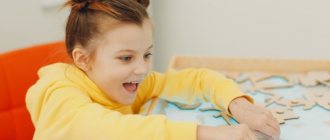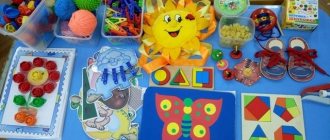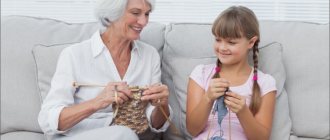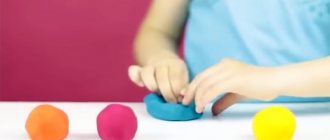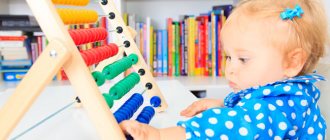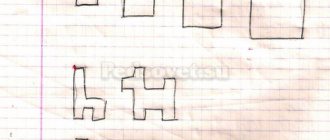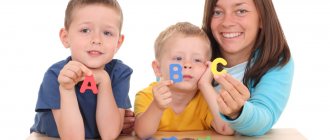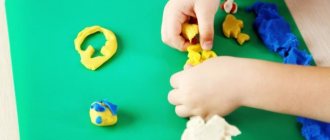Article:
Fine motor skills are the ability of a person to make small and precise movements of the hands and fingers and toes as a result of the coordinated actions of three systems: nervous, muscular and skeletal.
The development of fine motor skills in children is of great importance. Why? The area of fine motor skills of the hands covers a huge number of different movements. Fine motor skills help us make both primitive gestures (for example, picking up objects) and fairly small and complex movements (for example, writing). A person’s handwriting depends on the degree of development of fine motor skills.
The development of fine motor skills in children directly determines the quality of life.
A huge number of everyday activities are associated with fine motor skills: we have to fasten buttons and lace shoes, thread a needle. In addition, researchers have established a connection between the development of fine motor skills of the hands and the development of speech, so that the development of fine motor skills in children helps them speak faster and better. It turns out that the speech center of the brain is located very close to the motor center, which is responsible for finger movements. If you stimulate the motor center responsible for finger movements, the speech center is also activated! Therefore, the development of fine motor skills is necessary for the rapid and correct formation of speech skills.
Unfortunately, in the last decade, the number of children with speech disorders and writing problems has increased significantly all over the world. Thirty years ago, the percentage of such children was much lower! What is the reason for this phenomenon? It’s just that in the old days there were no shoes and clothes with Velcro. But there were lace-up shoes, clothes with buttons, hooks and ties. The children tied their shoelaces, fastened buttons and hooks every day, thus training their fingers! After all, such movements require dexterity and the development of fine motor skills. And now children are freed from the complex process of lacing shoes and carefully fastening buttons.
It turns out that children’s fine motor skills used to develop due to such ordinary actions, but now they suffer. Accordingly, speech skills also suffer, and problems with writing appear, because motor skills and speech are closely related.
The development of fine motor skills in children is a natural process; it begins to develop in infancy on the basis of general motor skills. The child begins with simple grasping gestures, then learns to transfer an object from hand to hand, and masters the “tweezer grip.” At two years old, the child is already able to hold a spoon and pencil correctly and begins to draw.
You need to start working on developing fine motor skills from a very early age.
Already an infant can massage his fingers (finger gymnastics), thereby influencing the active points associated with the cerebral cortex. In early and early preschool age, you need to perform simple exercises, accompanied by a poetic text, and do not forget about developing basic self-care skills: buttoning and unbuttoning buttons, tying shoelaces, etc.
V.A. Sukhomlinsky wrote that “the origins of children’s abilities and talents are at their fingertips. The more confidence in the movements of a child’s hand, the more subtle the interaction between the hand and the tool, the more complex the movements, the brighter the creative element of the child’s mind. And the more skill in a child’s hand, the smarter the child...”
Entering the 1st grade, children with difficulties in fine motor skills and insufficient development of hand-eye coordination skills experience difficulties with writing: their hand quickly gets tired, the working line is lost, and letters cannot be written correctly; “mirror” writing is also often encountered, when the child does not distinguish between the concepts of “left”, “right”, “sheet”, “page”, “line”, and do not fit into the general pace of work. All this negatively affects children’s assimilation of the 1st grade curriculum and necessitates the organization of additional exercises, the purpose of which is to prepare the child’s hand for systematic writing and to develop elementary specific graphic writing skills.
To achieve the goal, the following tasks have been identified:
- Combine games and exercises to train children's fingers and speech.
- Develop basic specific graphic skills.
- Prepare the child's hand for writing.
To solve problems I use the following tools:
- Development of graphic motor skills.
- A special place is occupied by shading, tracing figures or objects using a stencil, using simple and colored pencils. Coloring books are used for shading.
- Outlining. Trace the drawing exactly along the lines without lifting the pencil from the paper.
- Drawing patterns by cells. The sample has the beginning of a pattern; it needs to be continued.
- Drawing along anchor points and dotted lines.
- Coloring pictures.
- The use of physical education lessons, where children’s movements are combined with speech. Such physical education sessions help to switch to another type of activity, increase performance, relieve stress, and train mental processes (memory, attention, auditory perception).
- Hand massage, finger games, finger training help children master the elements of self-massage, have a healing effect on the child’s body, and improve the functions of the receptors of the pathways. Finger exercises in combination with sound gymnastics stimulate mental activity, promote a good emotional mood, improve the pronunciation of many sounds, and therefore develop speech.
Hand massage.
Hand massage is performed first on one hand, then on the other hand.
- Stroking from the fingertips to the middle of the hand from the outside and back.
- Kneading the fingers: intense circular movements around each finger.
- Intense movements of the thumb back and forth, up and down, in a circle.
- Flexion and extension of all fingers at the same time.
- Flexion-extension of the arm at the wrist joint.
- Intensive rubbing of each finger.
- Acupressure of each finger between the phalanges from the lateral and front-back sides.
Finger training.
- Clench your fingers into a fist and make circular movements with the brush to the left, then to the right. 4-5 times.
- Squeeze and unclench your fingers with force. 5-6 times.
- Straighten your fingers, move your thumb to the side and make circular movements with it, first to the left, then to the right. 4-6 times.
- Straighten your fingers, simultaneously bend and straighten the first two phalanges. 5-6 times.
- Spread your straight fingers, sequentially, in a fan-shaped movement, starting with the little finger, bend all fingers into a fist. Then, starting with the thumb, return to the starting position. 3-4 times.
- Clench your fingers into a fist. Try to straighten and bend each finger separately. Strive to ensure that others remain focused. The exercises are performed while sitting, with your elbows placed on the table. Gradually increase the number of repetitions to 10-15 times. After finishing the gymnastics, you should shake your relaxed hands and do a massage.
Finger games.
Finger games are the cultural heritage of the German people. They are fascinating, promote the development of speech, creative activity, develop dexterity, the ability to control their movements, and activate hand motor skills. Children use their fingers to depict objects, birds, and animals. All figures with a small poetic accompaniment.
- Games (didactic, theatrical, “theater in the hand”, role-playing) can increase overall tone, develop attention, memory, reduce psycho-emotional stress, and develop imagination.
- Thematic and thematic classes in appliqué, design, drawing, and modeling contribute to the development of cognitive and creative abilities, the development of children’s skills and abilities, coordination of finger movements, and promote speech development.
- Reading fiction and nursery rhymes expands the horizons of knowledge, stimulates speech and intellectual development, and expands vocabulary.
- The use of graphic exercises teaches one to navigate on a limited plane, develops the child’s mental activity, attention, and memory, and accustoms the hand to conscious, precise, purposeful movements.
To make the development of fine motor skills of the fingers an exciting game, I suggest using a variety of techniques not only at school, but also at home with parents:
- Finger gymnastics;
- Displaying various images using the hands (“glasses”, “chair”, “bell”, “bunny”, etc.), which can accompany the reading of nursery rhymes or fairy tales;
- Tearing paper of different densities and textures (napkins, newspaper, cardboard)
- Crushing paper lumps with your fingers;
- Sorting and sorting cereals and seeds (rice, millet, peas, beans, etc.)
- Tying and untying bows and knots;
- Fastening buttons, zippers, hooks;
- Stringing beads, buttons and small toys on fishing line, working with wire;
- Designing patterns from sticks and strips with different fingers;
- Modeling from plasticine.
- Construction
- Drawing with various materials (pencil, chalk, crayons, watercolor, gouache, etc.)
- Symmetrical cutting, appliqué, cutting out various figures from old pictures with scissors.
All types of classes are painstaking, interesting work that develops attention, improves sensorimotor skills - consistency in the work of the eye and hand, coordination of movements, and their accuracy.
When working on the development of fine motor skills, I adhere to some rules:
- I select tasks taking into account their gradually increasing complexity.
- I take into account the child’s individual characteristics, the pace of his development, capabilities, and mood.
- I carry out the work regularly, systematically.
- I follow the time limit so as not to overtire the child.
- I increase children’s interest in exercises and tasks by turning them into an entertaining game.
- I make sure that the child’s activities are successful, then his interest in games and activities is reinforced.
- I try to ensure that the process of learning and development creates positive motivation in children.
And in conclusion, I would like to say that the use of exercises, games, and tasks to develop and improve fine motor skills of the hand and fingers gives positive dynamics in the development of fine motor skills and the development of children’s speech in general.
References:
- Koltsova M. M. “The child learns to speak. Finger play training." St. Petersburg, 1998
- Primary school No. 23/1999. Preparing the hand for writing in seven-year-old children.
- Uzorova O.V., Nefedova E.A. 350 exercises to prepare children for school. M., “Aquarium”, 1998.
- Grizik T.I. Preparing a child to learn to write. M., “Enlightenment”, 2007.
Application
Exercises to make writing letters easier
To develop fine motor skills and prepare the hand for writing, I propose a technique developed by T.V. Fadeeva.
- Exercise 1. Palms lie on the desk. Children raise their fingers one at a time, first on one hand, then on the other.
- Repeat this exercise in reverse order.
- Exercise 2. Palms lie on the desk. Children raise their fingers on both hands at once, starting with the little finger.
- Exercise 3. Children hold a pen or pencil with their middle and index fingers. Bend and straighten these fingers, making sure that the pen (or pencil) does not fall below the thumb.
- Exercise 4. There are 10-15 pencils or counting sticks on the table. With one hand you need to collect them into a fist, taking one piece at a time, then also put them on the table one at a time (do this without helping with the other hand).
- Exercise 5. Children hold the handle with the second phalanges of the index and middle fingers and take “steps” along the surface of the table.
- Exercise 6. One end of the handle is clamped with the middle and index fingers of the right hand. In this case, the other end is directed away from the chest. You need to turn the handle over and place it in your left hand with the free end. Then, with the next flip, put the pen in your right hand, etc.
- Exercise 7. This exercise resembles moving a ball in your hands. Children, imagining that they have a ball in their palms, make movements that imitate turning the ball in different directions.
Exercises with a pencil
Unusual types of hand massage with a pencil are of particular interest to children because they combine tactile influence and play. You can perfectly learn these simple exercises with your child. Children really like exercises that are combined with reciting short rhyming poems.
Girls and boys, let's stretch our fingers. Let's rub a pencil and knead our palms! I roll the pencil in my hand and twirl it between my fingers! I will certainly teach every finger to be obedient!
Rules for conducting exercises with pencils
At first, the movements are done slowly. As the level of coordination improves, children's movements become faster as desired. To achieve the desired result, these exercises must be performed regularly.
You need to finish the exercises by stroking your hands (the movements imitate soaping your palms when washing your hands). “Shake” imaginary water from your fingers. "Iron"
I'll swing the pencil right and left - as I want.
Rolling a pencil along the surface of the table.
Take a thick pencil. Put it on the table. “Ironize” the pencil first with one palm, then with the other. Roll the pencil on the table.
"Making Fire" Rolling a pencil between your palms. Place the pencil on one palm and cover it with the other. Roll the pencil between your palms, first slowly, and then faster, from your fingertips to your wrists. Now try to do this with two pencils at once. Happened?
"Catch-up"
Fingers run forward, and no one lags behind.
Rotate the pencil around its axis with the fingers of both hands.
Take the pencil with all your fingers. Give it a spin. Let your fingers run along the pencil, catching up with each other.
"Swing"
I'll shake it up and down - Hold on tight, pencil!
Pressing the ends of the pencil alternately with the index and ring fingers onto the table surface.
Place a thin short pencil on the middle finger of your palm pressed to the table. Use your index and ring fingers to alternately press the ends of the pencil.
"Slide"
Rolling the pencil off the back of the hand. Place the pencil on the back of your hand. Tilt your hand down. Hold the pencil with your other hand. Let it roll down your hand like a slide.
"Top"
I roll circles on the table, I don’t let go of the pencil.
Rotating a pencil on the table with your index finger and thumb. Rotate the pencil on the table with two fingers, first of one hand and then of the other. Try doing the same with your thumb and middle finger.
"Helicopter"
Our handsome helicopter is taking flight.
Rotate the pencil between your thumb, index and middle fingers. Grasp the pencil with two fingers. Give it a spin. Let it rotate quickly, quickly, like a helicopter rotor.
"Relay race"
Pass the pencil to each finger in turn. Squeeze the pencil with your index finger, hold it, and pass it to the index finger of your other hand. Now hold the pencil with your middle finger. Pass the pencil like a relay baton with your other finger.
"Palm"
I’ll draw a palm, then I’ll rest a little.
Using the blunt end of a pencil, outline the palm of your hand lying on the table, massaging the interdigital areas with the pencil. Place your palm on the table. Spread your fingers wide. Trace each finger several times with the blunt end of a pencil.
Such massage and games with pencils stimulate the baby’s speech development, promote mastery of fine finger movements, and improve blood supply to the fingers.
Finger exercises
Family
Starting position: clench your fingers into a fist. Then straighten them one by one, starting with the thumb.
- This finger is grandpa
- This finger is grandma
- This finger is daddy
- This finger is mommy.
- This finger is me.
- That's my whole family.
(To the words of the last line, rhythmically clench and unclench your fingers.)
Days of the week
On Monday I did the laundry (we rub our fists together) I swept the floor on Tuesday. (relaxed hands down and make imitative movements on the table) On Wednesday I baked kalach, (we make “pies”) All Thursday I was looking for a ball, (we bring our right hand to our forehead and make a “visor”) On Friday I washed the cups, (fingers of my left hand half bent, the palm is on the edge, and with the index finger of the right hand we move in a circle inside the left hand) And on Saturday I bought a cake. (palms open and joined together on the side of the little fingers) Invited all my girlfriends on Sunday for their birthday. (we wave our palms towards ourselves)
